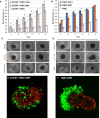Three-dimensional tumor model mimics stromal - breast cancer cells signaling
- PMID: 29416611
- PMCID: PMC5787462
- DOI: 10.18632/oncotarget.22922
Three-dimensional tumor model mimics stromal - breast cancer cells signaling
Abstract
Tumor stroma is a major contributor to the biological aggressiveness of cancer cells. Cancer cells induce activation of normal fibroblasts to carcinoma-associated fibroblasts (CAFs), which promote survival, proliferation, metastasis, and drug resistance of cancer cells. A better understanding of these interactions could lead to new, targeted therapies for cancers with limited treatment options, such as triple negative breast cancer (TNBC). To overcome limitations of standard monolayer cell cultures and xenograft models that lack tumor complexity and/or human stroma, we have developed a high throughput tumor spheroid technology utilizing a polymeric aqueous two-phase system to conveniently model interactions of CAFs and TNBC cells and quantify effects on signaling and drug resistance of cancer cells. We focused on signaling by chemokine CXCL12, a hallmark molecule secreted by CAFs, and receptor CXCR4, a driver of tumor progression and metastasis in TNBC. Using three-dimensional stromal-TNBC cells cultures, we demonstrate that CXCL12 - CXCR4 signaling significantly increases growth of TNBC cells and drug resistance through activation of mitogen-activated protein kinase (MAPK) and phosphoinositide 3-kinase (PI3K) pathways. Despite resistance to standard chemotherapy, upregulation of MAPK and PI3K signaling sensitizes TNBC cells in co-culture spheroids to specific inhibitors of these kinase pathways. Furthermore, disrupting CXCL12 - CXCR4 signaling diminishes drug resistance of TNBC cells in co-culture spheroid models. This work illustrates the capability to identify mechanisms of drug resistance and overcome them using our engineered model of tumor-stromal interactions.
Keywords: CXCL12; CXCR4; TNBC; three-dimensional culture; tumor-stromal signaling.
Conflict of interest statement
CONFLICTS OF INTEREST Authors declare no conflict of interest.
Figures










Similar articles
-
Targeting the cancer-associated fibroblasts as a treatment in triple-negative breast cancer.Oncotarget. 2016 Dec 13;7(50):82889-82901. doi: 10.18632/oncotarget.12658. Oncotarget. 2016. PMID: 27756881 Free PMC article.
-
Organotypic breast tumor model elucidates dynamic remodeling of tumor microenvironment.Biomaterials. 2020 Apr;238:119853. doi: 10.1016/j.biomaterials.2020.119853. Epub 2020 Feb 7. Biomaterials. 2020. PMID: 32062146 Free PMC article.
-
Therapeutic Targeting of Stromal-Tumor HGF-MET Signaling in an Organotypic Triple-Negative Breast Tumor Model.Mol Cancer Res. 2022 Jul 6;20(7):1166-1177. doi: 10.1158/1541-7786.MCR-21-0317. Mol Cancer Res. 2022. PMID: 35348758 Free PMC article.
-
Targeted nanoparticles for image-guided treatment of triple-negative breast cancer: clinical significance and technological advances.Wiley Interdiscip Rev Nanomed Nanobiotechnol. 2015 Nov-Dec;7(6):797-816. doi: 10.1002/wnan.1343. Epub 2015 May 12. Wiley Interdiscip Rev Nanomed Nanobiotechnol. 2015. PMID: 25966677 Free PMC article. Review.
-
The role of the CXCL12-CXCR4/CXCR7 axis in the progression and metastasis of bone sarcomas (Review).Int J Mol Med. 2013 Dec;32(6):1239-46. doi: 10.3892/ijmm.2013.1521. Epub 2013 Oct 11. Int J Mol Med. 2013. PMID: 24127013 Review.
Cited by
-
Deciphering Common Traits of Breast and Ovarian Cancer Stem Cells and Possible Therapeutic Approaches.Int J Mol Sci. 2023 Jun 26;24(13):10683. doi: 10.3390/ijms241310683. Int J Mol Sci. 2023. PMID: 37445860 Free PMC article. Review.
-
Quantitative Size-Based Analysis of Tumor Spheroids and Responses to Therapeutics.Assay Drug Dev Technol. 2019 Apr;17(3):140-149. doi: 10.1089/adt.2018.895. Assay Drug Dev Technol. 2019. PMID: 30958703 Free PMC article.
-
Cell-Inspired All-Aqueous Microfluidics: From Intracellular Liquid-Liquid Phase Separation toward Advanced Biomaterials.Adv Sci (Weinh). 2020 Feb 11;7(7):1903359. doi: 10.1002/advs.201903359. eCollection 2020 Apr. Adv Sci (Weinh). 2020. PMID: 32274317 Free PMC article. Review.
-
The role of tumor microenvironment in drug resistance: emerging technologies to unravel breast cancer heterogeneity.Front Oncol. 2023 May 17;13:1170264. doi: 10.3389/fonc.2023.1170264. eCollection 2023. Front Oncol. 2023. PMID: 37265795 Free PMC article. Review.
-
Chemokine signaling in cancer-stroma communications.J Cell Commun Signal. 2021 Sep;15(3):361-381. doi: 10.1007/s12079-021-00621-7. Epub 2021 Jun 4. J Cell Commun Signal. 2021. PMID: 34086259 Free PMC article. Review.
References
-
- Hanahan D, Weinberg RA. Hallmarks of Cancer: The Next Generation. Cell. 2011;144:646–74. - PubMed
-
- Balkwill FR, Capasso M, Hagemann T. The tumor microenvironment at a glance. J Cell Sci. 2012;125:5591–6. - PubMed
-
- de Kruijf EM, van Nes JG, van de Velde CJ, Putter H, Smit VT, Liefers GJ, Kuppen PJ, Tollenaar RA, Mesker WE. Tumor–stroma ratio in the primary tumor is a prognostic factor in early breast cancer patients, especially in triple-negative carcinoma patients. Breast Cancer Res Treat. 2011;125:687–96. - PubMed
Grants and funding
LinkOut - more resources
Full Text Sources
Other Literature Sources

